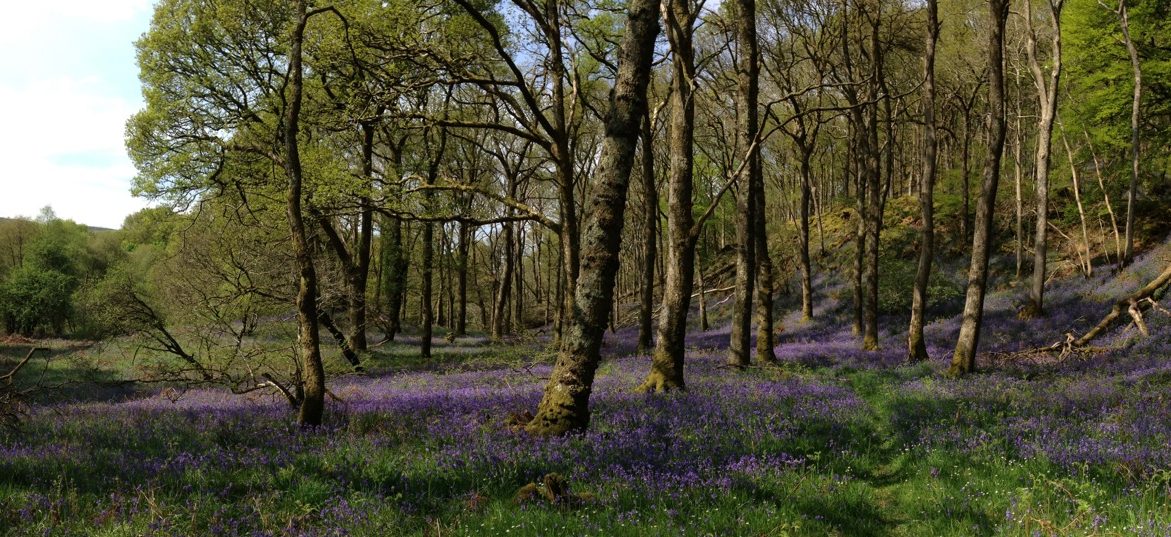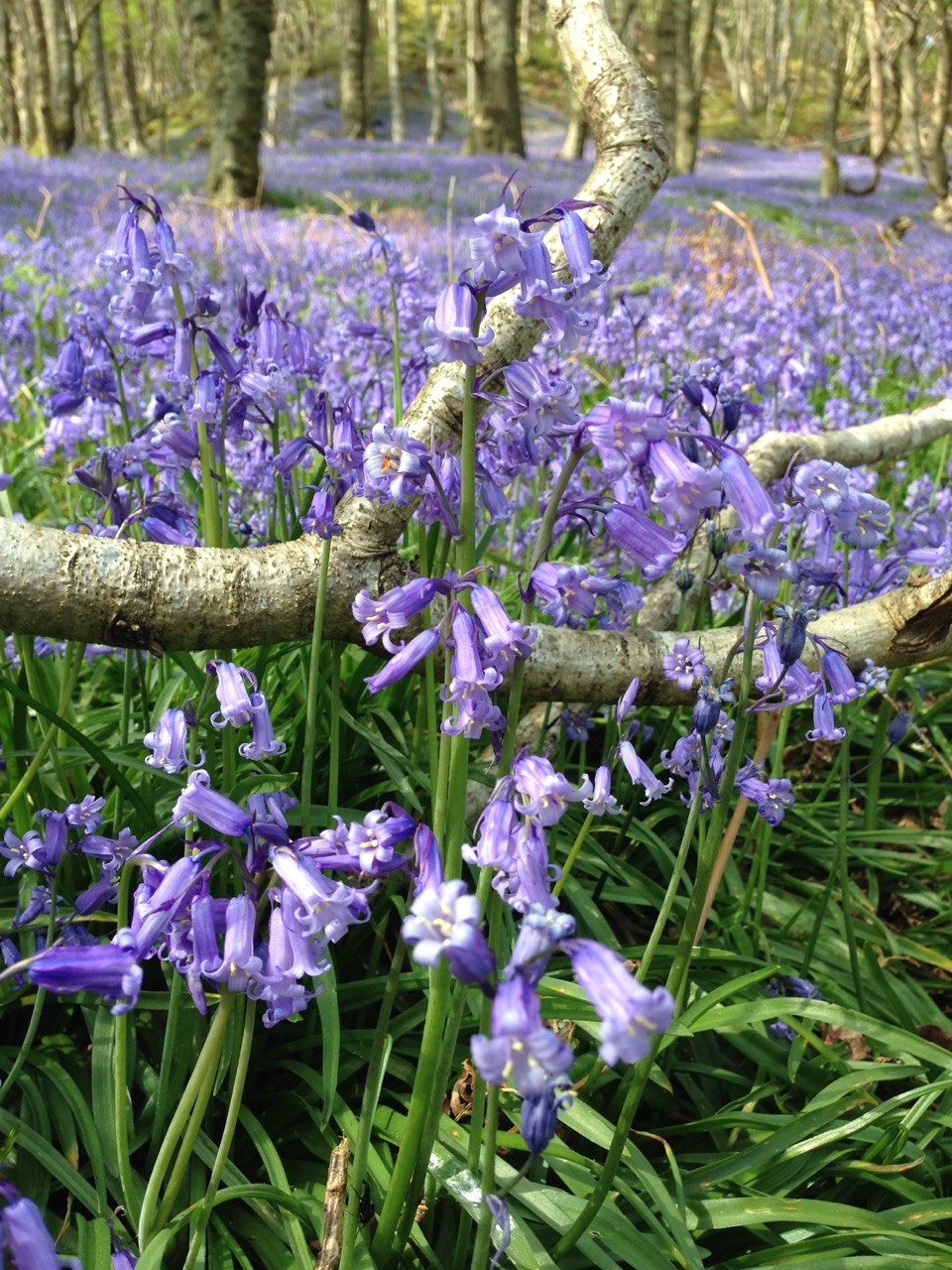How to describe the colour of bluebells? Covering the woodland floor they form an elusive hue, complex and impossible to replicate on film; emitting a cool ultramarine glow under shade, yet at the same time a warm pink-lilac haze in the shafts of light falling between the trees. The bells themselves range from electric blue to vivid periwinkle with thin stripes of cobalt running along soft bleached-mauve petals; in the dappled sunlight they create a spectacular display, each making its contribution to the pointillistic vision of blueness. They light the woodland floor with intense vibrancy, yet somehow this makes a gentle atmosphere, soothing, romantic, nostalgic.
The pigment that makes this complex colour is called Malonylawobanin
, or O-(6-O-(trans–p-coumaroyl)-β-D-glucosyl)-5-O-(6-O-malonyl-β-D-glucosyl)delphinidin! Along with at somewhere between 15-25 biologically active compounds, this seems to offer them protection against insect and animal damage, UV radiation and temperature fluctuations. Each year they time their flowering to peak just before other woodland plants and tree leaves block the light and this specialist adaptation to their ecological niche ensures that they can grow with little competition in the difficult conditions under dense shade of beech and oak trees, using stored nutrients from their bulbs.
Carstramon Wood (also Castramont Wood) is an ancient oak woodland surrounding Castramont House, now gifted to the Scottish Wildlife Trust. The approach from Anwoth takes you on a raised parallel road giving a magnificent view down across the river valley where it meets the forest. The newly leafing trees gather like clouds up the hillside, and (this year in mid-May) a delightful transformation occurs – contained behind the stone wall and settled as if first snow, lies a glimpsed shade of blue resting between the bases of the lower trees.
When they first started to flower the bluebells were a deeper colour, reminiscent of lapis lazuli; their upper buds still closed and pointing upwards, others angling outwards and some beginning to bend down and open slightly. The stems at the top were a dark, inky indigo becoming green towards the ground. Some of the buds were pale green and the flower stalks attaching them to the stem an intense ultramarine blue. The shiny, glinting leaves were more visible, covering the forest floor in a haphazard crisscross. Magnificent beeches were the first trees in leaf, vibrant splashes of fresh green; new growth so light it appeared as though suspended. Every now and then appeared a white bell glinting brightly in the sunlight, a rare mutation of the native flower, rather than a Spanish invader. The bracken was sending up new shoots, its fronds not yet unfurled, but clasped loosely on curved stems emerging like snakes from the undergrowth. The wood felt very calm and quiet, save for birdsong high up in the canopy, and the echoing call of a cuckoo across the meadow.
A few days on, and the woods feel very different, warm and heavily perfumed; a tawny owl glides lazily across my path down towards the river. Many more trees have started to turn green, honeysuckle has started its curl around trunks and the heat of the last few days has brought the flowers out fully; each stem with every bell released from bud. Little tracks cross deeply through the flowers, enabling you to be completely surrounded by hazy clouds of bluebells, continuing into the trees in every direction, beyond into the distance ascending further up the slopes.
The bells are an intricate mix of colours now, the intensity of first bloom has softened into a warmer bleached-mauve with sky blue stripes. The stems are green to the top, the colour is in motion; once dark-tipped stalks have lost their pigment. The tiny bracts beneath the flowers are a warmer violet and the visible pollen is cream or white. The bells are narrow with curly tips, cascading down the stem in a gentle arc. In Carstramon the old trees are encrusted with moss and lichens, giving a warm soft covering to parts of the trunk where tiny pink-striped wood sorrel have seeded. Where the bark shows it sparkles in the light beams, this silver-grey compliments the lilac bells in a heart-aching way.
The wood is full of lines and pathways; animal tracks making thin green lines of exposed leaves and trodden bells; the slight reveal of orange earth on a wider human path; the shadows cast from trees making lines of deeper colours. Old fallen trees make mossy tramlines through the blue and branches emerge like ancient sculptures from the ground surrounded in a pool of violet.
Up on a moss filled stump a few plants have seeded; it is a nice contrast to see the plants as specimens above the mass spread below. The colours and textures in a bluebell wood are simultaneously restful and vibrant, with an alluring combination of deep shadow and bright highlights. The vivid emerald leaves, emerging in vertical spikes from the woodland floor, angular yet softened by a haze of petals; the warm green of moss and lichens breaking up solid lines of fallen branches; the silver-orange of wood and twigs against sunlit arching stems; the deeply shaded side of trees softened here and there by the creep of ivy; the upright lines of hundred of trunks distracted by the soft first green of opening foliage glittering in luminous horizontal flickers; the pastel blue sky glowing through the shapes made between branches as they decrease in width and height, fading into the distance.
Ferns emerge through the leaf straps against the hazy horizon, growing up to the light in crown formations, their ammonitic spirals still held taught. Glimpses of other hilltops appear through windows in the trees, some green and others golden with gorse.
The dense press of flowers continues upwards through layers of forest, undaunted by the sheer ascent, channeling streaks of light between trunks as they plummet towards the path below. The intensity of colour seemed most concentrated here, broken only by the first tips of feathery bracken and the thin path below.
Still the bluebells go on, up and up and eventually open out across a higher enclosed clearing.The purple flowers covered the floor in every direction downwards towards me, seeming to flow like a glacier from a slope high up between a stand of trees, leaving a rubble of old bracken in its path.
We tend to think of bluebells as a swathe of colour, but more often the dominant colour is green, the leaves and stems underneath the flower. In these Scottish woods there is an addition of soft apricot brown from last year’s bracken and longer grasses which have died back – these seem to be Galloway colours of Spring, blues of the sea and reflections over shallow water with the pale oranges of sand and sunlight breaking it up.
Finally I emerge into the warm sunlight near the summit of the Doon of Castramont, the smell of hot wood merging with the intensifying bluebells. The colours seem different here, warmer, and sun-bleached. Into another wooded height, almost at the peak, the woodland floor is sunlit and dry, lightly dappled with newly emerging leaves of the thin canopy.
Birds flit around the treetops, sillouhetted against the bright sky; at this time of year Carstramon welcomes back migrant birds; pied flycatchers, redstarts, wood warblers and willow warblers return to breed. The heat of the sun is intense, and it is a welcome relief to descend back into the woodland, and the cool swathes of bells.
The English bluebell, Hyacinthoides non-scripta is a protected species under the Wildlife and Countryside Act 1981. The UK contains about half of the world’s remaining flowers which can be found in hedge lines, hillsides and coastal areas, as well as concentrations in woods. Invasion from introduced non-native varieties such as Spanish bluebells has potentially been catastrophic for the native flowers, as they have hybridised from nearby gardens, and purely native bluebell woodlands are becoming rare. This, along with habitat loss and over-collecting of bulbs have left the bluebell vulnerable, consequently landowners are prohibited from removing common bluebells on their land for sale and it is a criminal offence to remove the bulbs of wild common bluebells. This legislation was strengthened in 1998 under Schedule 8 of the Act making any trade in wild common bluebell bulbs or seeds an offence, punishable by fines of up to £5000 per bulb. Some licences have now been granted to collect seed from native plants for propagation to provide nurseries with bulbs for gardeners who wish to remove introduced varieties and replant. English bluebells are an indicator species for ancient woodland, where they have remained undisturbed for hundreds of years, spreading slowly in their preferred environment, often in slightly acidic soil in oak, beech and broadleaved forests.
www.wildflowerfinder.org.uk Very good info on bluebells and wildflowers (bandwidth limit means site is sometimes unavailable)
Carstramon Reserve info Wildlife Trust
Plantlife Bluebells for Britain report
Royal Botanic Garden Edinburgh research
BBC article on hybridisation
Carstramon Wood is a nature reserve managed by the Scottish Wildlife Trust, near the beautiful town of Gatehouse of Fleet in Dumfries and Galloway.
Flowering information 2016
Visits 2016 May 6th (flowers just opening, plenty of buds, deep colours), 11th May (fully out, colour changing, perfect display, strongly scented), 18th May (some bells on stems over and vegetation growing up through flowers)


















